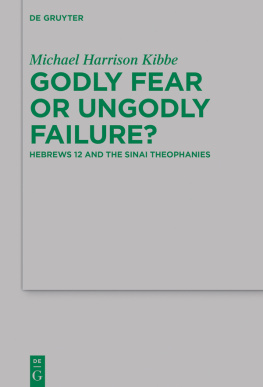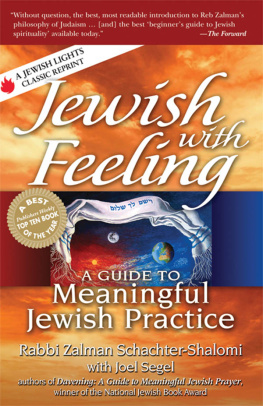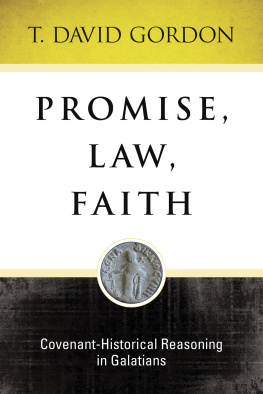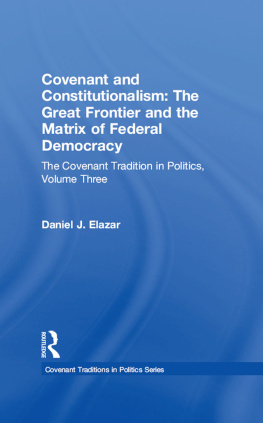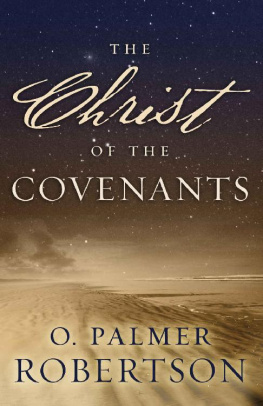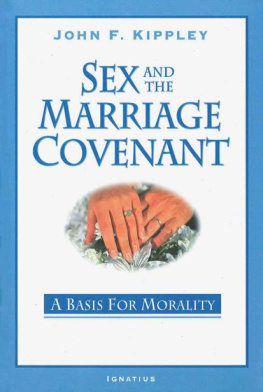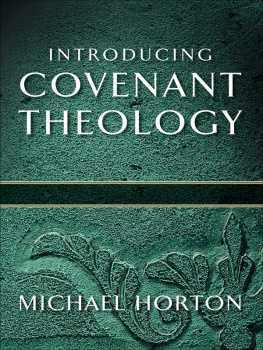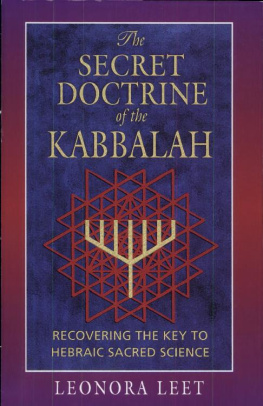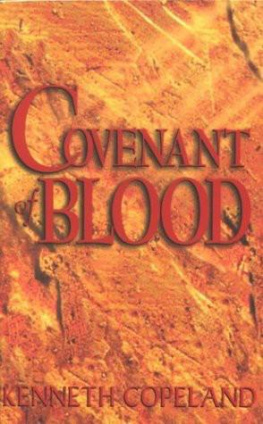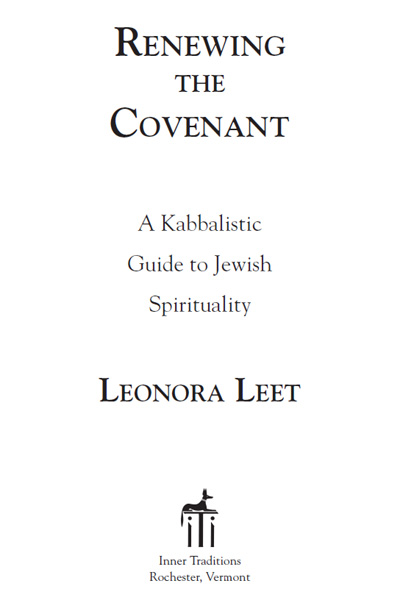To my dear daughters
Tamar Brodwin Goodman and
Susannah Rachel Brodwin
Preface
The covenant, that instrument of divine grace through which God bound Himself to Abraham in a special relationship of obligation and empowerment, was renewed by God with the two succeeding Patriarchs and with Israel at Sinai and Moab. Each of these specifically Jewish covenants can be associated with a particular spiritual practice: the Patriarchal Covenant with Father Isaacs practice of meditation; the Sinai Covenant, centered in the Ten Commandments, with the Sabbath observance that is its sign; and the Moab Covenant, comprising the whole of the Torah, with the form of prayer derived from the declaration of faith, called the Shma, that appears directly after the Moabite repetition of the Ten Commandments. These covenant-related practices form a ladder of increasing potency, and this work will show how these rungs of the covenant can each become available for personal renewal.
This is the first of a four-book project on the Kabbalah begun in l978. The second will be published in the spring of 1999 by Inner Traditions and will be entitled The Secret Doctrine of the Kabbalah: Recovering the Key to Hebraic Sacred Science. This larger work will develop the new interpretation of the Jewish mystical tradition that is more briefly touched on here, providing the theoretical foundation and larger cosmological context for much of the treatment of the Jewish spiritual practices with which we will be concerned in this book. The present book may be said to complete the more theoretical formulations to follow by developing from authentic sources practices that can fulfill the goal of that conjoined human and cosmic evolution my books will show to have always been projected by this mystical tradition.
The forthcoming book will give full acknowledgment to the many individuals who have helped me in various ways through the years with this ever expanding project. But I would like to give special mention here to St. Johns University for the generous support it has given to this project through research leaves, teaching reductions, and in the final preparation of the manuscript, with particular appreciation to former Vice President Paul T. Medici and the Faculty Support Center. Finally, I wish to express my deepest gratitude for the support and various forms of help given to me by five remarkable individuals most knowledgeable about the mystical heart of Judaism: Zalman Schachter-Shalomi, Aryeh Kaplan, Michael Lerner, Gerald Epstein, and especially my dearest friend Esse Chasin.
CHAPTER 1
Covenantal Judaism
Spiritual Practice and the Covenants
A revitalization of Jewish spirituality is what the present moment especially calls for, and this book attempts to contribute to such a revitalization by providing a new approach to Jewish ritual practice appropriate to the new era of the world and of Judaism on whose threshold we now are standing. To that end, the following three chapters are concerned with ascending levels of spiritual practice, each of which can be correlated with one of the three specifically Jewish biblical covenants, those with the Patriarchs and with Israel at Sinai and Moab. The subjects of these chapters will range from the rediscovery of forgotten meditative practices, in the second chapter, to reformulations of the most basic of Jewish practicesSabbath observance and ritual prayerin the third and fourth chapters. In each case the Bible will be reexamined to determine the essential nature of those practices that claim to convey sanctification or empowerment. The remainder of this section will be devoted to introducing the later chapters that detail these covenant-related spiritual practices, the next section to exploring the larger historical context for this new approach to the Torah, and the final two sections to offering more radical suggestions for integrating such practices into a new mode of Jewish covenantal commitment that can tap into its original power while renewing its nature.
It may well be asked whether such a new interpretation of Scriptural Law is necessary when a complete and coherent interpretation of the Lawthe Oral Torah of the talmudic traditionis already in place. Indeed, the tradition that derives from the talmudic sages and contains the accumulated strength of millennia of communal devotion has developed its own spiritual power to sanctify its adherents, and there is clearly no reason for anyone who experiences the empowerment transmitted through this tradition to wish, or need, to alter his or her practices. But the spirit conveyed through the rabbinic tradition is not the same as that which can be tapped directly through observance of the Mosaic Torah, and for many the tradition of the rabbis no longer enhances but impedes their spiritual progress toward communion with God. It may be time, therefore, to try once more to provide new paths either to enter or reenter the treasurehouse of Jewish spirituality. These paths to religious experience and power may become a satisfying end in themselves or the beginning of a further journey both back to more traditional modes of observance and forward to endowing such traditions with new Kavanot, new spiritual enhancements. The Mosaic Torah details three levels of specifically Jewish covenant, and this new approach to the ladder of increasingly demanding and potent covenantal practices may aid many to ascend to ever higher levels of mystical Judaism.
The first practice with which we shall be concerned is also one that extends beyond the specific lineage of Abraham, namely directed meditation. Since the only biblical figure to be specifically associated with the practice of meditation is the Patriarch Isaac, it seems appropriate to correlate meditation with the Patriarchal Covenant. We are told that coming from the way of the well Lahai-roi (Gen. 24:62),
Chapter 2 concerns kabbalistic meditation. It begins with a brief summary of kabbalistic concepts in the first section and proceeds to an extended study of classic kabbalistic texts on meditative practice in the next section. A later section considers the Sefer Yetzirah, the first extant text of the Kabbalah, dated as early as the third century C.E., and shows that this seminal kabbalistic text contains encoded directions for a particular meditative technique. Its method of verbal repetition is the focus of this later section, which contains a full-scale treatment of the process of meditative attunement and techniques to lift one into the meditative state specified by classic Jewish texts. This is followed by a guided Master Meditation, a form of directing the will while in the meditative state to achieve both transformation and knowledge. This form of directed or hagah meditation is the standard mode of meditation detailed in the kabbalistic texts on meditation discussed earlier in the second section.
For those whose practice has not yet been extended to include the traditional ritual prayers, there is a section prior to the full instructions for meditation that develops a mode of performing the essential Shma of Deuteronomy 6:45 as a prelude to a meditation, and that may be regarded as bringing the practice of meditation within the sanctity of Torah. The section on the Shma is further introduced by one that provides evidence from early Jewish sources for such a combination of meditation and prayer. In the form of the Shma developed in this context, as in the following guided meditation, use is made of the biblical word vehayah, which the King James Version translates as and it shall come to pass. Here I suggest that this was actually a biblical power word for directing the manifesting power of God, but comprehensive support for this claim is reserved for the appendix. The central credal affirmation of the Shma, normally translated as Hear, O Israel, the Lord our God is one Lord, will be further considered in the extended treatment of liturgical prayer in the culminating fourth chapter. Thus, though the Shma is properly the mark of the new covenant enacted at Moab just prior to Israels entrance into the Promised Land, the subject of chapter 4, it seems worthwhile to introduce a form of its performance into the logically prior practice of kabbalistic meditation both to bring the power of Torah into the meditative act and to ensure this connection to Torah for those who might make the full meditative process presented in chapter 2 their primary form of spiritual practice.



